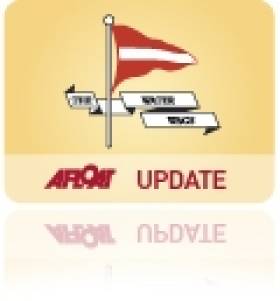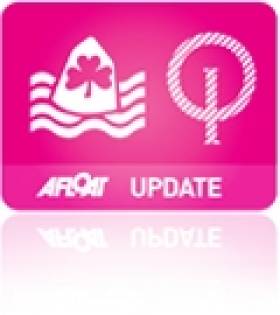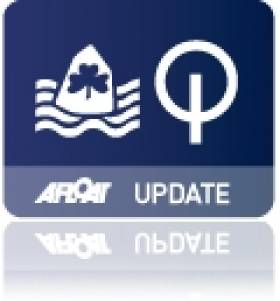Displaying items by tag: Royal St George Yacht Club
Just Who Do The Irish Sailing Association Think They Are?
#irishsailing – Ireland's national sailing authority has been going through turbulent times in recent years. With unprecedented expansion of ISA staff numbers as the country revelled in the boom years of the Celtic Tiger, the arrival of the inevitable and abrupt financial downturn found an Association bloated, unfit to cope, and out of touch with ordinary sailors.
High profile events, top level training and international participation had become so dominant in the ISA's range of activities that many of the ordinary sailors of Ireland already felt the Association was no longer relevant to their own low key personal pursuit of friendly sport afloat.
When the crash came, it led to a marked decrease in active sailing numbers as disposable incomes fell away. People focused on keeping their jobs and businesses afloat rather than their boats sailing, while many promising young sailors were forced to emigrate.
This new reality was reflected by the growing disillusion of club officers, who saw their membership subscriptions decreasing even while the ISA – which is largely reliant on subvention from the clubs for its own income – seemed always to be looking for more money. And at the height of the boom years, when all the major clubs had put through significant expenditure in developing their facilities to international standards, the ISA had shown its lack of contact with the reality of club life by proposing its own stand-alone National Sailing Centre in Galway, a facility which would in effect have been run in rivalry to the main clubs. To the mutterings in the grass roots were added the rumblings from above as major clubs threatened to withhold their annual payment to the ISA unless real reform was initiated. W M Nixon takes up the story.
In a classic grass roots revolution, club sailors Norman Lee from Greystones in County Wicklow and Bryan Armstrong from Sligo were at first rebuffed when they tried to voice their concerns about the ISA's increasing irrelevance to the needs of the vast majority of sailing enthusiasts, people at local level who were doing their very best to keep the sport alive through torrid times.
The Irish sailing community now owes these two men and their supporters a debt of gratitude, for they believed in what they were saying and they refused to be turned aside. Eventually, in November 2013 moves were in place to establish a Review Group for the urgent analysis of all ISA activities, and its personnel drew comprehensively on Ireland's remarkable pool of people with hands-on experience of running successful sailing events and organisations.
It was chaired by Brian Craig of Dun Laoghaire who has headed up the organising team on more major and notably successful international sailing events in Dublin Bay than probably anyone else, and its able personnel included two former ISA Presidents - Roger Bannon of Dun Laoghaire and Neil Murphy of Malahide and Howth - who had both been noted for their skill in running a tight ship when they were in charge. With them was highly regarded International Race Officer Jack Roy of Dun Laoghaire, and renowned sailmaker/activist Des McWilliam of Crosshaven, who each year is inevitably seen in busy involvement afloat in more Irish sailing centres - large and small - than anyone else in the boat world.
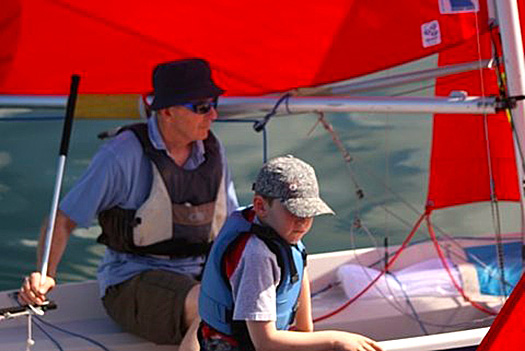
Bryan Amstrong of Sligo on the helm for a Mirror race
Also on board was one of the men from the barricades, Bryan Armstrong of Sligo. His background in a relatively remotely-located club which nevertheless has a long and distinguished sailing history made him uniquely qualified to voice the concerns of the grass roots. And we have to remember that all these people were giving voluntarily and generously of their time to this project in a period when Irish life was largely a matter of just getting through each day, while staying economically afloat was something of an achievement.
Primarily, the Review Group's function was to analyse the Association work on behalf of ordinary club sailors, as it was agreed that the Olympic and High Performance Divisions of the ISA's activities – which receive direct Sports Council grants – were in effect functioning as a different entity.
The Strategic Review Group was still work in progress when the ISA acquired a new President in David Lovegrove in March 2014, but by August the SRG published proposals which led to the setting up of a more formal body, the Planning Group. If this seems like a case of kicking the can down the road, it was anything but - these were people in a hurry, they'd got through the first stage of analysing areas where action was required, now they had to be more structured in coming up with clearcut ideas and concrete proposals.
This new Planning Group, which went into action in early Autumn 2014, was chaired by Neil Murphy, and its members included ISA President David Lovegrove, ISA Board Member Brian Craig, Ruth Ennis, Peter Redden, Sean Craig, and ISA CEO Harry Hermon, with noted Dun Laoghaire events administrator Ciara Dowling to provide administrative support.
They had their draft plan ready by mid-December 2014, and on January 21st 2015 Neil Murphy and his group publicly unveiled their analysis and proposals for the first time at a well-attended and very representative meeting in the Royal St George YC in Dun Laoghaire.
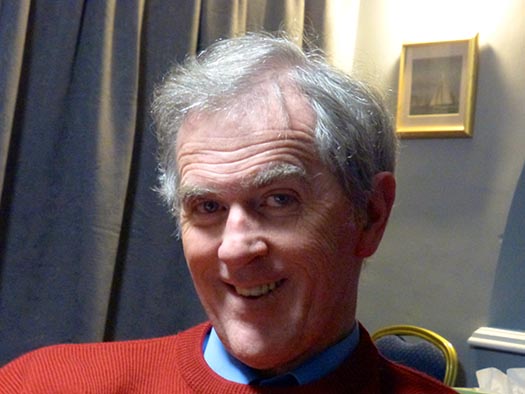 Neil Murphy is a former ISA President who, in addition to extensive experience as a Race Officer, is a typical club sailor, racing a Puppeteer 22 out of Howth. Photo: W M Nixon
Neil Murphy is a former ISA President who, in addition to extensive experience as a Race Officer, is a typical club sailor, racing a Puppeteer 22 out of Howth. Photo: W M Nixon
While those involved in setting the ISA on a healthier course are mostly working on a voluntary basis, it has to be said that the PowerPoint presentation and the printed material was of the highest professional class. In fact, it was much better than many professional shows I've been to, and the level of thought which went into a wide range of questions from the floor answered by Neil Murphy, Brian Craig and David Lovegrove generated a growing level of goodwill which concluded with Norman Lee voicing his congratulations and good wishes for this continuing process in which he and Bryan Armstrong had played such a key role.
So now we move on to the next stage – taking the ideas to the rest of the country. Doubtless you'll have noted the double meaning in titling this piece 'Just Who Do The ISA Think They Are?' In a first interpretation, that question is the one for which, let's hope, we are all now involved in working together in providing and implementing a satisfactory answer.
But equally, as the ISA Road Show gets out of Dublin to take this excellent presentation to a public meeting in Cork next week (it's in the Rochestown Park Hotel on Tuesday, Feb 17th, 7.0 pm to 9.0 pm) and then Galway the week after (Galway Bay Sailing Club, Tuesday 24th February 7.0 pm to 9.0pm), they'll be taking themselves into areas where experience of sailing administration long pre-dates the establishment of organised sailing on Dublin Bay.
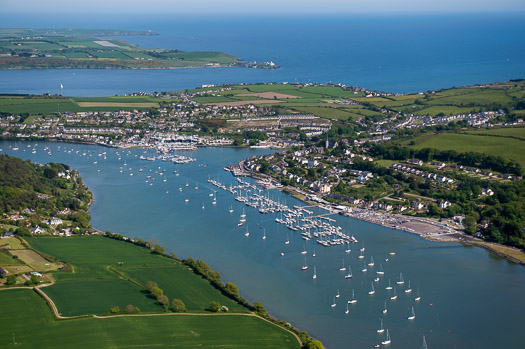 Crosshaven in the summer time. When we look at the natural advantages to be found here, it's little wonder that structured recreational sailing on Cork Harbour long-pre-dated any organised sport on Dublin Bay. Photo: Robert Bateman
Crosshaven in the summer time. When we look at the natural advantages to be found here, it's little wonder that structured recreational sailing on Cork Harbour long-pre-dated any organised sport on Dublin Bay. Photo: Robert Bateman
So you might well ask just just who do they think they are, these people from Dublin, going down to Cork to try to tell them how sailing should be organised? The nerve of them, doing it in a place where they've had organised sailing since 1720, and where the two biggest clubs – the Royal Cork and Kinsale – are both mighty establishments of international sailing repute which would remain so even were the ISA to disappear overnight in a puff of smoke...
And as for going west along the road to Galway, that will take them through Athlone where the Lough Ree Yacht Club dates back to 1770, while on the west coast the Royal Western of Ireland YC at Kilrush traces its origins back to 1828. Equally, further north along the Atlantic coast Sligo YC dates back to 1821, and in Lough Erne the club began in 1820. Yet the first club on Dublin Bay, the Royal Irish, only began as recently as 1831, and even then it barely hung in and had to be revived in 1846, with the pace being set in the meantime by the Royal St George YC, founded 1838.

Kinsale is another harbour which seems to have been designed with sailing primarily in mind. Photo: Kevin Dwyer/courtesy ICC

Kilrush on the Shannon Estuary had a club in being before there were any sailing institutions on Dublin Bay. Photo: W M Nixon
So in terms of sailing administration history, Dublin and Dun Laoghaire are only Johnny-come-lately places by comparison with just about everywhere else in Ireland. Yet thanks to the inevitable dominance of economic development, population growth and the strengthening centres of political power, we now find that sailing administration and decisions of national import are emanating from a place that, in terms of natural sailing advantages, lags far behind the rest of the country.
Oh for sure, Dun Laoghaire Harbour is a fabulous artificial amenity, and the advent of the new marina at Greystones has already been seized upon as greatly increasing the "cruising" options of Dublin Bay. But let's face it, Dublin Bay is really only good for racing, specific day sailing and training, whereas Cork Harbour and Kinsale provide such a variety of opportunities for interesting race courses, mini-cruises with multiple destinations and what have you, that in effect they're not just in a different part of the country – they're a different country altogether.

Dun Laoghaire is a totally artificial facility, and sailing options on Dublin Bay are limited. But it's inescapable that this is the primary point of leisure access to the sea for Ireland's largest and most affluent population. Photo: Kevin Dwyer/courtesy ICC
All of which adds to the difficulties of creating a meaningful national authority with which every sailing person can identify.
This business of Dublin v The Rest is not unique to sailing, of course, but when you have a specialist sport with multiple sub-branches of activity, the problem is exacerbated.
So please bear this in mind if you take yourself along to the meetings in Cork or Galway during the next ten days. This really is a genuine attempt to base the ISA within the sailing community at an everyday level of usefulness to all, with scope for growth while enhancing existing structures, and input from the sailing community at this stage will help in developing the ideas and initiatives proposed.
While the draft ISA Strategic Plan 2015-2020 very definitely puts the emphasis back on to the need for healthy well-run clubs as the basis for the sport, there was initially a feeling at the meeting on January 21st that the new-look ISA is not supportive of commercial sailing schools. In fact, what the new-look ISA hopes to do is encourage training schemes within clubs, while at the same time supporting commercial sailing schools where the demand is such that no club could realistically cope while maintaining its essential club ethos.
Going into this in more detail in a personal meeting this week with Neil Murphy, who is a Chartered Quantity Surveyor, we talked around the fact that a thriving club scene is central to the spirit of Irish sailing, and he was musing on the success of Sutton Dinghy Club where Hugh Gill heads up what is in effect a commercial sailing school within a club setting.
In fact, what Murphy would hope to see emerge at larger population centres is sailing's equivalent of the public golf course. Anyone who has used a public golf course will be aware that the proprietors are usually mustard keen to encourage the formation of a "club" within their customer base, and there is no reason why this shouldn't eventually take root in Irish sailing, providing access to sailing at a fraction of the cost of joining an established club.
It's not something which can realistically be objected to by established clubs trying to protect their own membership, as the people who would use a "public sailing club" would be those who simply couldn't afford to go sailing at all in the current traditional club setup.
Nevertheless support for the established club setup is central to the new Strategic Plan, and the provision of Regional Development Officers to serve clubs directly is very much to the fore in the new thinking. But in looking over the figures published with the report, it's good to note that the ISA works with no less than 80 recognised training centres, while an encouraging statistic is that there are now 24 secondary schools in Ireland which include sailing as a regular part of their curriculum. Admittedly it's a long way from the French setup where every schoolkid is entitled by law to one week of sailing and one week of skiing per year, but in a country where an aversion to being on the water used to be thought inevitable, it's a step in the right direction.
All these considerations of inexpensive sailing are a whole world away from the stories of recent weeks and days about the ISA's High Performance Division seeking a fund-raising executive who will be tasked with finding €2.75 million per annum through philanthropic and other donations in order to help the funding of top level campaigns which we're not allowed to call Olympic campaigns, as apparently that is copyrighted by the Olympic Council, so we call them High Performance instead.
But apparently Government departments aren't restricted by this limitation on the use of the word Olympic, for it was bandied about like nobody's business in this week's news that the government is spending mightily through the Sports Council, with sailing being number three in all Ireland in terms of current Sports Council funding, with a total tag of €1,289,900.
Of course it's not all for specifically Olympic sailing, but it covers 103 sailors from Optimists to the Olympics. Which is fine and dandy for those who are mad keen to race at the highest level, but most sailors in Ireland are much more interested in performing well within their chosen area and boat class, but with sailing being just part of a reasonably civilised and well-balanced life.
And as became evident at the meeting on January 21st, there's an increasing number of people who feel that sailing needs to realise that there's a sizeable population out there of folk who'd like to go sailing, but don't feel the almost religious vocation to own a boat.
With the rapid expansion of sunshine sailing holidays with boats and equipment readily available for hire at the destination, there's a strong feeling there's a real need for more of this in Ireland, even if we can't guarantee the sunshine. The suggestion brings us back to both the "public sailing club" concept, and the growing realisation by established clubs that they have to reach out to potential members by having boats available for sailing on a trial basis.

The Affordable Sailing Team – Norman Lee (right) with his brother Ken beside their campervan at last year's GP 14 Worlds at East Down YC on Strangford Lough. Photo: W M Nixon
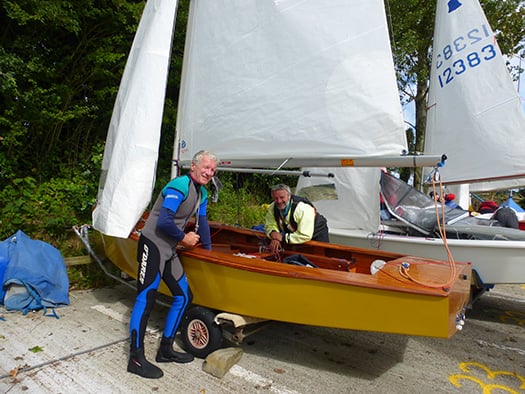
With their own very high can-do standards of boat maintenance, Norman and Ken Lee can keep their GP 14 in the competitive frame. Photo: W M Nixon
That said, the need to own one's own boat and tune and tinker with her to your heart's content is what sailing is all about for many of us, and Norman Lee is a classic case in point for this approach. He claims that his sailing costs him just €600 per year, though that of course is after he has paid for his well-tuned GP14, and he has long since written off the cost of the vintage camper-van which is home to the Lee Equipe when they hit the campaign trail.
Nevertheless the entire setup has to be outstandingly good value, and doing it in such economical style is part of the fun of it all. So when someone with Norman Lee's approach to sailing is prepared to get up at the big ISA public meeting in Dun Laoghaire and congratulate the team who have been working on the reforms which he and Bryan Armstrong set in train, then that is approval of a high order.
And as for just who or what is the ISA, can we maybe agree that ideally we all are the ISA, every last one of us who goes sailing or is even just interested in the sport, and it's up to us to keep it in line and encourage it to identify with and serve the ordinary sailor every bit as much as the high-flyer.

Private pleasure.....the 2014 GP 14 Worlds at East Down YC is about as high as many Irish sailors would expect or want to aim, and many are content with much lower-key regular club sailing. Photo: W M Nixon
Santa Arrives By Boat At National Yacht Club, Dun Laoghaire
#santa – Santa Claus arrived by boat yesterday into Dun Laoghaire harbour and headed straight to a packed National Yacht Club where sackfuls of presents were handed out to children of all ages.
Everyone – big and small – was entertained all day long, with the very special guest of honour arriving at noon and accompanied by his Elves.
Next weekend (December 14) Santa is scheduled to make another waterfront appearance at the Royal St. George Yacht Club and on the other side of Dublin Bay at Howth Yacht Club too.
Glen Keelboat Class Fleet Celebrate Fifty Years of Sailing
#glensailing – The Glens are celebrating 50 years sailing and racing together as a class in Dublin Bay Sailing Club, writes 'Glenshane' skipper Pete Hogan. As a very successful season draws to a close for the 12 or so Glens in Dublin Bay there seems all prospects that the fleet can continue for a further 50 years.
The story of the Glens is worth repeating. Designed by the celebrated Scottish Marine architect Alfred Milne in 1945 the Glens were built by the Bangor boatyard over the following 20 years. Possibly 39 Glens, at least, were built which gives them claim to be Milne's most successful design and also one of the last of Alfred Milne Senior's designs. The firm still exists. He also designed the Dublin Bay 21's and the 24's which were recently in the news on Afloat.ie
At first the Glens were confined to the North but started appearing in Dublin over 50 years ago. Glenluce G67 celebrated last year being 50 years in the sole ownership of the O'Connor family. They started racing together as a class under DBSC organisation in 1964 and have been racing ever since.
Glens are classic little yachts, retaining their looks up to today as reminders of what sailing boats looked like before the era of plastic mouldings, high freeboards and self-draining cockpits. 25 ft. long with a full keel and sensible sail plan they represent state of the art pocket cruisers of the period.
Glens were often compared to Dragons. They are heavier, shorter and carry a bit more sail. But they were never allowed to become the development class which the Dragons became and never made the seismic shift into fibreglass construction. Their handy size however, has allowed them to survive just as the 17's in Howth survive and thrive. There is a mini wooden boat building fraternity centred on the Glens and their needs. The Brennan boatbuilding family in Dun Laoghaire, all three generations of it, being its mainstay.
Moored out in front of the Royal St George YC and each painted a distinctive different colour, the Glens have become as iconic a fixture in Dun Laoghaire as the bandstand, Teddy's ice cream shop or the fishermen casting their lines from the pier. Long may they continue.
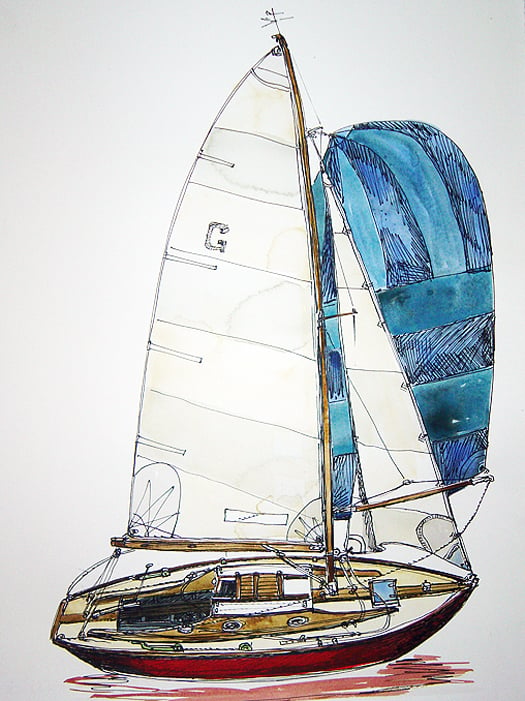
The Glen keelboat. Illustration by Pete Hogan
Anyone interested in getting involved in the Glen Class in Dublin could contact Pete on 087 930 9559 or click HERE
Encouraging Young Sailors Into Keelboats & A 'Cool' Ship In The North Sea
#islandnation – Heir Island, which is mistakenly called 'Hare Island' and in Irish is known as 'Inishodriscol' is one of "Carbery's Hundred Isles," that are "scattered," as some descriptions put it, throughout Roaringwater Bay on the West Cork coastline. It is two-and-a-half kilometres long, with spectacular flora and fauna.
Historically the island formed part of the O'Driscoll clan territory and was known as Inis Ui Drisceoil or Inis an Oidhre. The English version of the name has been traditionally misspelt as "Hare" ---- since 1694 at least, so the islanders claim.
It is also the location of Heir Island Sailing School, a Training Centre approved by the Irish Sailing Association and which for the past two weeks has been training future keelboat sailors amongst a coterie of interested youngsters.
Encouraging young people into sailing is very important for the future of the sport so it is good to hear positive reports about the innovation introduced on Heir Island in to teach young sailors the skills of keelboat racing.
"We can't take credit for the natural environment," John Moore who, with Patricia, runs Heir Island Sailing School, told me. "But what we can do is develop an interest in sailing as an active, enjoyable for sport for everyone and widen the interest of young people in aspects of the sport."
With residential accommodation available at the centre the Irish Cruiser Racing Association which has overseen the running of racing for keelboats, chose it as the base for a new initiative "Keel Boat Race Week." ICRA has the job of bringing together the various aspects of Irish handicap racing. Since its inaugural meeting in 2003 when sailors, primarily from Cork and Dublin, met in Waterford to establish the Association it has built a solid core of interest among cruiser racing enthusiasts. It has also led the successful Irish winning of the top UK international trophy, the Commodore's Cup.
With Heir Island Sailing School the initiative, open to all junior sailors in the country was launched, aimed at Transition Year students in particular, to run two week-long courses for young sailors keen to broaden their sailing and racing experience. The school year schedule for 'Transition' provided the way to do this and those committed to the future of the sport took the opportunity.
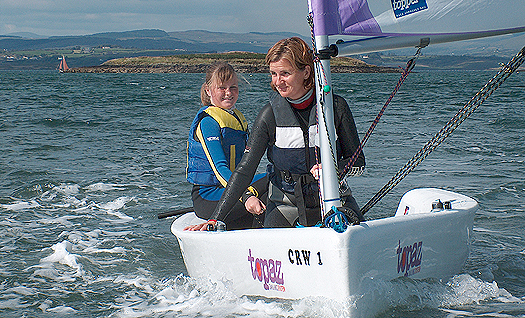
Twenty-five young sailors took part in the first of the two weeks and sixteen were involved on the second week, all keen to broaden their sailing and racing experience. A team of expert coaches, using six, matched, open keelboats taught them to develop skills associated with racing keelboats including handling the mainsail, headsail trim, bow work, helming, tactics and spinnaker handling. Ben Fusco, Head Coach at the Royal St George Yacht Club in Dun Laoghaire, a student yachting world champion, was chosen by ICRA to be involved in this project as well as Ben Lynch, an offshore sailor, who has raced aboard Volvo Open 70s and competed in some of the world's most challenging offshore races.
"At the end of the course they have gained familiarity with the various roles on keel boats as well as an appreciation of the tactics and strategy used throughout keel boat races," John said. The youth sailors came from areas around the coast. "They have also learned how to adapt the dinghy approach, in the boats they would have been sailing up to now, to bigger, more powerful boats".
There is a near-permanent difficulty in getting and keeping crews for cruiser racers, as I know from personal experience, so building up a reservoir of future sailors is important for the sport. One of the biggest problems has been the loss of young sailors after they leave dinghies. Many of them do not to remain in the sport.
Encouraging them to do so and developing the youth interest is important. In this regard Whitesail racing has provided an opportunity for families to race together. At the Friday evening racing in the RCYC in Crosshaven we adopted a youth policy aboard my own boat, a 33ft. Sigma and put our youngest crew member on the helm, a 10-year-old sailor from the Optimist bronze fleet. The training young sailors get in those little boats is impressive.
Conditions were mostly light enough during the three-race series for Oisin, my grandson, to helm our boat with tactical advice from the senior members of the crew. We won the series with a 1st and 2nd in a tie-breaker with the next boat, Micheál Lynch's, Lady T, both finishing on 9 points. Micheál deserves a lot of praise for his commitment to whitesail which has encouraged more people to take their boats out racing and enjoy the experience. It was good to see the way in which the RCYC sailors encouraged our young helm. The future of sailing will depend heavily on those who race for enjoyment. Without them, the highest competitive level of the sport will not have a foundation upon which to develop.
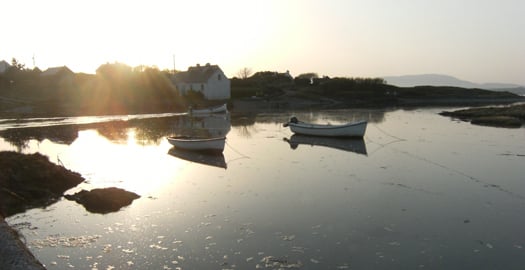
Heir Island
So let's give more encouragement to the youngsters. They will take over eventually, one way or the other (!) But helping them along will benefit the sport – and perhaps more boats and owners! When Oisin took over on the helm I went to where I have been on other boats - sitting on the rail. There is a different perspective there. It didn't lessen my overall concerns, because being owner I still have to sign the cheques when equipment and replacements are needed (!) but I did take a lot of satisfaction from seeing a youngster from the Optimist fleet handle the helm of a 33ft. cruiser effectively and I did learn – that we can all be replaced !
'COOLEST' SHIP IN THE NORTH SEA
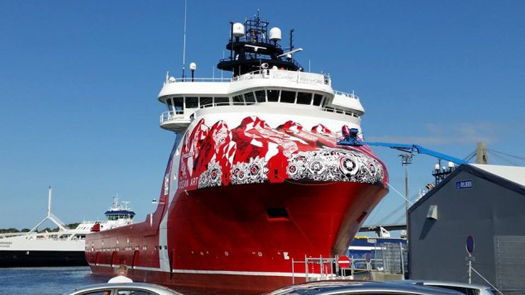
There are not too many ships as brightly painted as the one pictured here, the new vessel launched for the Norwegian offshore supply shipping company Atlantic Offshore, Ocean Art PSV, in Stavanger. It was built at the Kleven shipyard in Myklebust, Norway and named during the ONS offshore energy conference in Stavanger, which coincided with the Nuart street art festival. A Polish street artist, Mariusz "M-City" Waras, painted the ship. It is the second of two VS 485 MKIII L designs ordered by Atlantic Offshore from Kleven and is to go on a six-year contract with Statoil in the North Sea. They claim it is the "coolest looking" ship in the North Sea! It certainly won't be un-noticed.
THE NAVY CALLS BACK!
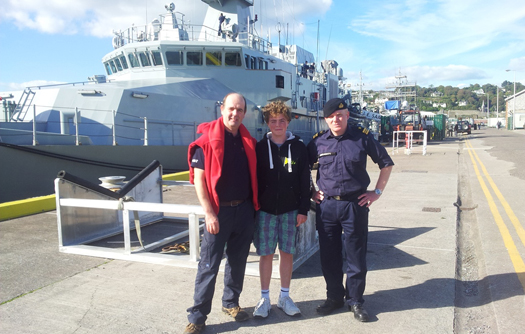
John Hegarty, skipper of odd job at MBSC, his son Morgan and Lt. Cdr. Tony Geraghty, Commander of LE Samuel Beckett at the Naval base
I described, back in July in this blog how I was crewing aboard a yacht out of Monkstown Bay in Cork Harbour in that club's Thursday night cruiser league when the VHF came alive with the first radio call I had heard from the new Naval vessel, 'SAMUEL BECKETT' which had come up astern of us, returning from sea patrol. The Naval voice courteously requested if 'ODD JOB,' the yacht on which I was crewing, would alter course in the 'narrows' as the water area off Cobh and between Haulbowline Island is called by sailors, so that the State warship could make her approach to the Naval Base. Our Skipper, John Hegarty, acknowledged with equal courtesy and called a tack so 'ODD JOB' came about to go astern of 'L.E SAMUEL BECKETT' which then went into her berth at the Base. We brought 'ODD JOB' about again and returned to the racing fray, but the alteration cost us first place on handicap by two minutes and forty seconds. However, this incident showed the value of courtesy and good seamanship. The Navy showed equal courtesy in making contact after they read the story here on the Afloat website. We were invited to visit the ship and were shown over it by her commander, Lt.Cdr.Tony Geraghty. She is an impressive vessel. I recorded an interview with Lt.Cdr. Geraghty which will be transmitted on my THIS ISLAND NATION radio programme and which you can hear next week here on afloat.ie
130 YEARS OF DUBLIN SAILING
As a Southern sailor, I have to admire the sight of all the sails in Dublin Bay out of Dun Laoghaire which I have seen over the past two Saturdays when my journeys took me along the seafront. It was very impressive, a great panorama of the sport and an indication of just how big the marine leisure sector is and its potential importance to the national economy. Congratulations to Dublin Bay Sailing Club which celebrated its 130th Anniversary at the weekend. The club has made a great contribution to the development of sailing since it was founded in 1884 and has co-ordinated racing in and out of Dun Laoghaire harbour. It has also influenced the development of yacht design through classes such as the Dublin Bay 25s, the Dublin Bay 21s, the Dublin Bay Mermaids and the Dublin Bay 24s. When marine correspondent with RTE I saw the efficiency of the DBSC in running sailing events. Long may it continue.
GETTING RID OF A SPY SHIP

November 5 should be an interesting day on the web. Rosatom which is a Russian State Corporation, will be holding an auction for bids to demolish the warship, SSV-33 Ural, that was launched in 1983. Nuclear-powered, it was regarded as a "spy" ship but hadn't a successful career. After less than two years in operation, there was a fire aboard and, with the fall of the USSR, there wasn't enough money for repairs, so she was taken out of service. The ship must be disposed of within the Bay of Bolshoy Kamen in the Primorsky region by November 30, 2017. Nuclear fuel was unloaded from the ship's reactor and removed for recycling in 2009. Parts of the ship are to be used to repair other nuclear-powered Russian naval vessels.
THIS ISLAND NATION EXPANDING
From next week my THIS ISLAND NATION radio programme is moving from monthly to fortnightly transmission. It will be broadcast here on the afloat website, so I hope you will tune in.
Until next week, the usual wish of .....
"fair sailing..."
Email: [email protected]
Twitter: @Tom MacSweeney
Royal St.George Yacht Wins J24 National Title on Lough Erne
#j24 – Flor O'Driscoll's Hard on Port from the Royal St.George Yacht Club in Dun Laoghaire has taken the J24 national title for 2014 after three days of racing at Lough Erne Yacht Club in Co Fermanagh.
In the final day of racing at the Northern Ireland club, Hard on Port took line honours in the penultimate race of the day to set up the Royal St George Yacht Club entry for the title.
Stefan Hyde's RCYC entry, Hamilton Bear, pressed hard on the final day but was unable to mount a challenge strong enough to grasp the title away from the vastly experienced Munster man at the helm of Hard on Port.
Lighter winds were an ease to the competitors after the two previous days of gruelling conditions and with the sun shining down on Lough Erne, the trip up north paid off for the visiting boats.
Line honours for the last race of the day went to U25 crew on Kilcullen from Howth Yacht Club as local boat Jamais Encore pressed for a runner up spot.
Results:
Overall - Hard on Port Flor O'Driscoll RstGYC
Runner up - Hamilton Bear Stefan Hyde RCYC
3rd - Kilcullen Gordon Stirling HYC
4th - Jamais Encore JP McCaldin LEYC
5th - Crazy Horse Tim Corcoran Sligo
#fireball – Royal St. George Yacht Club Fireball pairing Barry McCartin & Conor Kinsella continue to knock on the door of the international Fireball scene. After a hat–trick of domestic titles, the Dun Laoghaire duo won the pre-Europeans, were fourth at the Europeans in the Shetlands and have just finished fifth at the UK Nationals at Tenby Sailing Club in Pembrokeshire, only narrowly behind a number of pro–teams.
With the event already in the bag for Tom Gillard & Richard Anderton, the final day could have been an anticlimax and in terms of the podium places it probably was. However the Fireball Nationals always offers more, and with prizes to play for across the fleet there was plenty of action in the last 2 races.
Race 9 got underway on a gate start in a fresh Northerly breeze around 13 knots. Ian Dobson & Tim Linsell got off to a flyer and in lovely sunny conditions they went on to take a well deserved race win.
For the final race of the series the wind freshened just before the start and the fleet enjoyed some champagne Fireball conditions to end the week. Gillard & Anderton displayed the form they had shown throughout and won it from Dobson & Linsell, with the Irish duo Barry McCartin & Conor Kinsella getting a well deserved 3rd. In the Silver fleet, Simon Lomas-Clark and Rob Daniels had an absolute flyer, carding a seventh to bring them within one point of a fleet win. Oh so close!
FInal top five, gold fleet:
1. Tom Gillard & Richard Richard Anderton
2. Ian Dobson & Tim Linsell
3. Matt Burge & Simon Wheeler
4. Dave Wade & Tim Hartley
5. Barry McCartin & Conor Kinsella
#waterwag – Following a day with winds of force 5 it was a surprise to arrive in Dun Laoghaire to find almost no wind at all. Our valiant Committee boat team of Tom, David T, and Tuffet laid a windward-leeward course of three laps. When the twenty-one Water Wags were ready to start the wind shifted from the west to the south west. They quickly relayed the course. Signals were hoisted and about 3 minutes before the start the wind shifted further towards the south, creating a bias on the start line. Gavotte, Pansy, Tortoise, Mollie and Swift were all set for a port start, but they hadn't predicted that Good Hope would get the perfect start on starboard tack. Several of the port tackers had to dip Good Hope.
Over the fist beat the wind was unstable with an average of 3-4 knots but with regular gusts of 6-8 knots. At the windward mark Pansy tacked inside Mollie, but as she had not regained sufficient speed after the tack to hold her place. Mollie sailed over her. On the run Pansy was able to blanket Mollie as they vied for position on the run. It was time to prepare fore the leeward gate. Pansy opted for the southerly mark while Mollie took the northerly mark. Over the next beat, it was Pansy who appeared to hold a good wind heading towards the Ferry berth, but as she was further inshore the wind failed her and she fell back some 6 boatlengths behind Mollie who had taken a tack towards the harbour mouth. Pansy fell into the clutches of Gavotte and Tortoise. Mollie had done enough to pull clear ahead of the bunch. On the offwind leg Tortoise showed great speed and overtook Gavotte. This time all the leading Water Wags headed for the northerly gate buoy to repeat the success of Mollie the previous time around.
On the beat Tortoise tacked away onto starboard before Pansy or Gavotte. Would she find the wind bend which would lift her up to the windward mark across the harbour? It wasn't to be. Pansy rounded the windward mark with only one tack while Tortoise had to put in three. At the next leeward mark Mollie headed for the eastern mark. Was this a good idea? She had everything to lose.
Then Pansy who realised that there had been a wind shift further to the south, and followed Mollie. On the final beat Moosmie started to put pressure on Tortoise and Gavotte as the approached the finish.
The final order was:
1st Cathy MacAleavey and Con Murphy in Mollie.
2nd. Vincent Delany and Noelle Breen in Pansy
3rd Frank Guy and Owen McNally in Gavotte.
Meanwhile in Division 1B, Good Hope was enjoying the benefits of her good start and rounded the windward mark six places ahead of her rival Eva. But through the race Eva was gaining places and they finished in 8th and 10th places respectively.
1st Division 1B. Hal Sisk in Good Hope.
2nd. Orla Fitzgerald and Dermot O'Flynn in Eva.
In Division 2 the challenge was between Penelope and Phyllis. Initially Penelope got the upper hand but as the race developed Phyllis overtook and took the win.
1st. Division 2. Paul and Anne Smith in Phyllis.
2nd. Fergus Cullen and his daughter in Penelope.
The race for the J.H. Stephens Tankard was a good result for the National Yacht Club and Royal St. George who took the three podium places.
#ruffian23– The Ruffian 23 National Championships - hosted by the National Yacht Club were held in conjunction with the J109 National Championships at the weekend. Download results below.
Race officer Jack Roy held 3 races on Friday in very foggy conditions and winds of between 12 and 18 knots. The fleet of 12 Ruffians included 2 who had sailed down from Carrickfergus to compete in the event. Carrageen helmed by Trevor Kirkpatrick, defending Ruffian 23 national champion and commodore of Carrickfergus Sailing Club led on 5 points, followed by Ann Kirwan helming Bandit from the National Yacht Club on 6 points, and Chris Helme of the RStGYC on Diane II with 7 points.
Saturday saw racing abandoned at 1500 due to fog and lack of wind.
In order to achieve a championship Jack Roy needed to hold a 4th race on Sunday. Perfect conditions with 12-18 knots of breeze and very good visibility ensured that 4 windward-leeward races were sailed. Dianne II won 3 of these securing her 1st place by a point from Trevor Kirkpatrick from, Carrickfergus sailing Carrageeen. Bandit helmed by Ann Kirwan from the NYC was 3rd.
Brendan Duffy helming Carmen from the DMYC was first in the silver fleet.
#oppiEuros2014 – After three days of glorious sunshine for the Optimist European Championships when Dublin Bay rivalled the Costa Smeralda, yesterday's fog was succeeded by what in Ireland is called a soft day – drizzle and mist - but at least there was reasonable wind.
The new conditions did seem to suit the Irish better than their rivals. In the boys' gold fleet James McCann, lying 14th overnight, rose to 10th, equaling his best ranking so far. In the girls' Gold Clare Gorman who was back in 32nd place this morning sailed an excellent race. On the final leg in shifting winds she sailed a very conservative last beat to finish 14th and raise her over-all ranking to 23rd. Gemma McDowell of Malahide and Alix Buckley of Skerries retained their placings in this illustrious company.
In the boys' Silver fleet (52-102 of the 153 boat fleet) Harry Bell had the best day of the Irish boys and lies in the top half of this division and therefore in the top half of the overall ranking. Among the girls Dara Donnelly achieved an excellent 8th place.
As for tomorrow the sun is trying to break through but this is Ireland and weather-wise almost anything is possible.
The new conditions clearly did not suit many of the sailors on the overnight leaderboard with the notable exception in the girls' Gold fleet of Ebru Bolat, sailing for the Royal Romanian Yacht Club. She had a superb race. In the top pack from the start, on the shifty final beat she and Pia Dahl Andersen (Norway) broke free on the right hand side and Ebru finished second.
She is now sure of a medal with a 26 point lead and her only rival for gold, Spain's Iset Segura, must come in the top two tomorrow to win the event. Martina Müller from Lake Zürich remains in bronze position but the group behind her is very close and includes Alexandra Stalder (Italy), renowned for having won the 850+ boat Garda Meeting in 2013, currently in fourth place.
In the boys' Gold fleet leader Enzo Balanger from Guadeloupe sailing for France sailed his discard in 20th He is still ten points clear of his main rival Kasper Nordenram (Sweden) but the main beneficiary of the new conditions were Daniel Toh of Singapore who won the race and German Lennart Kuss from the famous Baltic sailing venue of Warnemund who came 4th.
'Ar Nós Na Gaoithe' – Optimist Championship Competitors from 44 Countries Try Out Irish
#OppyEuros2014 – After two days of competition, 255 Optimist sailors from 44 nations are getting used to the wind and the waves of Dublin Bay but what about the local lingo? The enterprising videographers at the Royal St. George Yacht Club asked a few of the Under–16 competitors to get their mouth's around the Irish phrase Ar Nós Na Gaoithe [as fast as the wind]. Just like the sailing, there were varying degrees of success!
Racing in the final qualification rounds continues on Dublin Bay this morning with two more races before the fleets are split into gold, silver and bronze.
Winds on the bay are light enough at 5 knots as the boys fleet of 153 boats begin to launch.
































